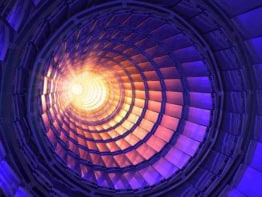The first evidence for "tetra-neutrons" -- nuclear clusters containing four neutrons and no protons -- has been found at the GANIL accelerator in France. An international team of researchers detected six candidates for the four-neutron clusters among fragments of neutron-rich beryllium nuclei that were produced in a collision experiment. The team hopes to confirm its discovery in future experiments, an achievement that would have a major impact on our understanding of nuclear forces (F Marques et al 2002 Phys. Rev. C 65 044006).
Studies of the interactions between nucleons — neutrons and protons — in small nuclei are crucial for theories of nuclear binding in larger nuclei. Physicists know that pairs of neutrons can exist in an ‘almost bound’ state – that is, if they interacted any more strongly, they would form a “di-neutron”. This has led to speculation that larger numbers of neutrons could form clusters, which might be found in nuclei that contain many more neutrons than protons.
Over the last 40 years, several collision experiments have been conducted to search for neutron clusters. But these experiments have been unable to tell the clusters apart from single neutrons that are also ejected in the collisions, because neither have an electric charge. Now a new technique has provided the first hints of them.
In the GANIL experiment, led by the CNRS Laboratoire de Physique Corpusculaire in Caen, neutron-rich nuclei were broken up, and the fragments were then collided with protons. The make-up of these fragments was then deduced from the energy of the recoiling protons and the time the fragments took to reach the protons.
The researchers carried out the experiment on beams of neutron-rich lithium-11, boron-15 and beryllium-14 using the UK CHARISSA and the Franco-Belgian DEMON detector arrays. An analysis of the data led by Francisco-Miguel Marqués identified six protons with energies that could be explained most easily by collisions with newly formed tetra-neutrons.
The researchers admit that other effects in their experiment could have mimicked the presence of tetra-neutrons, but believe that these account for no more than 10% of the signal. They plan to conduct similar experiments next year with better fragment detectors, a more intense beam of beryllium-14, and a beam of helium-8 nuclei, which is also expected to form tetra-neutrons.



